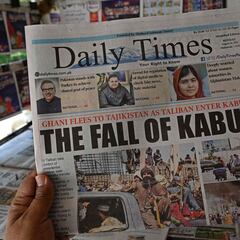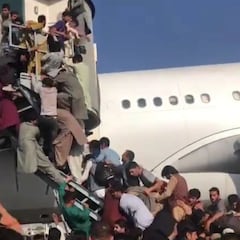Why has the United States left Afghanistan, how many soldiers did it have, and how long had it been there?
The US is in the process of evacuating its military, diplomatic personnel and the Afghans that collaborated with them at the end of the 20-year conflict.


Why has the US left Afghanistan?
President Biden has claimed back in July that the US had accomplished its goals in Afghanistan. He said in the July 8 remarks that the goals were to get justice for the September 11 attacks and to degrade the terrorist threat that Afghanistan posed. It seems these remarks were hopelessly misjudged after the events of the last week.
Osama bin Laden was caught, and executed, but not in Afghanistan. He was found hiding in its neighbor, Pakistan. While Al-Qaeda has not threatened the US in the last decade and a half, other terrorist cells have posed huge threats to global security. The return of the Taliban could put the US under as much threat as it felt from Afghanistan back in 2001, and the British defense secretary Ben Wallace thinks that Al-Qaeda "will probably come back," after the Taliban victory.
U.N. Secretary-General Antonio Guterres called on the Security Council to ‘use all tools at its disposal to suppress the global terrorist threat in Afghanistan’ and guarantee that basic human rights will be respected https://t.co/0Dvxia4wE3 pic.twitter.com/xfwVvVWozO
— Reuters (@Reuters) August 16, 2021
In reality, the US and NATO are tired of the war. Biden claimed the US was not in Afghanistan for a "nation-building project," but a 20-year military presence undoubtedly produced some sort of nation whether it was the intention or not. Maybe senior American commanders genuinely thought the Afghans could defend their state against the Taliban on their own, but evidence such as the abandonment of Bagram airbase overnight without telling the Afghans, shows the amount of respect and trust the US felt toward their allies. The rapidly deteriorating military situation, in which the whole country collapsed in just two weeks, shows how wrong the public statements were.
Although polling has not taken place since the fall of Kabul, the withdrawal of American troops was viewed overwhelmingly positively by the American electorate. A poll by Chicago Council found 70% of Americans supported leaving Afghanistan, while 29% opposed it. The pictures coming out from Kabul may swing public opinion when people are confronted with the fall out of the withdrawal.
Related news
- What is Afghanistan's situation in the Middle East and which countries does it border?
- Kabul residents overrun airport in scramble to flee Taliban
- Who funds the Taliban in Afghanistan?
- Who are the Taliban and what are their motives?
- What is behind the Taliban's rapid advance in Afghanistan?
How many soldiers did the US have in Afghanistan?
Despite a high-water mark of 100,000 US troops in the country, during the Obama administration in 2011, the number of combat forces was reduced in 2014 to around 10,000. This coincided with the withdrawal of other NATO soldiers, with close ally Great Britain's soldiers departing in 2014.
And although there was a growth of troops to 14,000 during the Trump presidency, the signing of the Doha agreement set in motion the plan to remove all US and NATO troops and the only remaining soldiers are those assisting the evacuation.
How long was the US invasion?
After the September 11 attacks in 2001, former President George Bush demanded that Afghanistan, then ruled by the Taliban, surrender the head of Al-Qaeda, Osama bin Laden, who as hiding in the country. When this was declined, the US invaded on 7 October 2001 and has been embroiled in the war ever since.
Between then and the fall of Kabul on August 15, the war was waged for close to twenty years. In comparison, US involvement in the Second World War and Vietnam was under four years and eleven years respectively, making it the longest war in the United States' history.
How many have died?
Since 2001, there have been more than 3,500 deaths of NATO coalition soldiers. Almost 4,000 defense contractors have also been killed, and well over 30,000 members of the coalition were wounded. In addition, more than 65,000 members of the Afghani Security Forces and police have been killed.
"Kabul residents are living in absolute fear right now."
— Bloomberg Quicktake (@Quicktake) August 16, 2021
Afghanistan's ambassador to the UN, Ghulam Isaczai, says the Taliban have begun searching houses in the capital city, "looking for people in their target list" https://t.co/2kXRjDL1qF pic.twitter.com/eSMcs6mqlb
Related stories
There is no official death count for Taliban fighters called. The Watson Institute estimated that around 51,000 fighters have died, but the researchers preface the figure by saying it is most likely an undercount.
From the civilian side, around 71,000 Afghani and Pakistani civilians have died due to the war. The war has also led to the internal displacement of 3.2 million Afghans, with at least 2.1 million fleeing to other countries.

